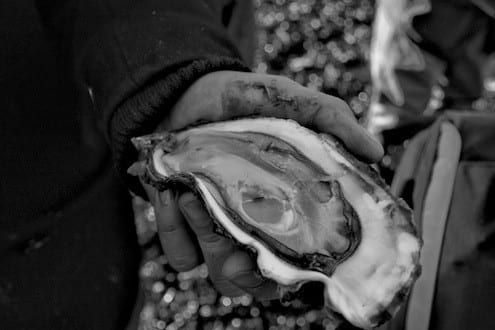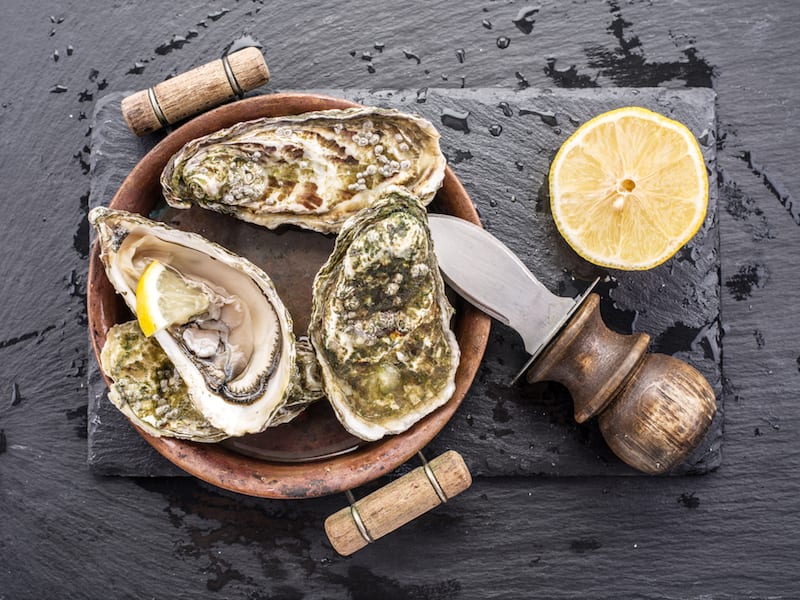Kasper is a former food critic who has changed sides…
Oysters have always been considered a great delicacy, and some of the best in the world are found in Limfjorden in Denmark.
By Kasper Fogh-Hansen
Oysters tell the tale of delicate wet areas and natural diversity. The small mollusks have always been surrounded by myths and magic. Casanova allegedly ate 50 oysters every day, naturally served by some dazzling beauty: It is the food of lovers, sucking the essence out of life. It has been claimed to be an aphrodisiac, which science can’t confirm, but a young couple sharing a stable of oysters have an undoubtedly erotic quality. Maybe because since antiquity oysters have been the delicacy reserved for special celebrations and most dear guests. Julius Caesar was rumored to have invaded Britain in search of its oysters: In Denmark, where possibly the best oysters in the world live in a protected natural reserve, the king would ultimately install capital punishment for oyster thieves, keeping the delicacy for his own tables.
There is a journey in every oyster. Once you open and smell them there is a fresh breeze on your face from the sea and the wild. The Romans brought the flat shelled oysters from the Atlantic region of Europe back to Italy packed with in ice, snow or in barrels with sea water. Oysters are woven into the cultural fabric of Europe as the essence of fine foods.
In North Jutland a sound called Limfjorden is home to the largest remaining wild oyster bed of the endangered original European oyster. The waters they live in are practically the northern border of the European oyster’s natural habitat. It’s often too cold for the oysters to spawn, and the population is very volatile being depleted in cold winters.
”The oysters are practically living on a razors edge, several cold winters will kill large parts of the population. But they have much better bite, than regular oysters – they are simply more meaty. You haven’t really tried oysters until you’ve had this” says head chef Boris Buono of Copenhagen’s oldest and most prestigious fish restaurant “Krogs”. He is passionately in love with the classic, flat shelled European oyster. Oysters are a tale of exclusivity, of the fresh pure taste of the sea, of lovers and aphrodisiacs – and also of a fragile environment.
Boris is one of a young generation of chefs that have drawn the gastronomic community to Copenhagen, being a veteran of the young and uber-creative chefs that eventually started a Nordic revolution in top gastronomy around the restaurant Noma, several times winning the award of best restaurant in the world. He is of a generation that threw out the chemists of the modern cuisine, and replaced their approach with botany and zoology, demanding that nature, not the lab, should be the foundation of cooking – and that natural diversity should be displayed in the food culture. Bringing attention to the special oysters is a part of a new generation of chefs also communicating on biodiversity and the need to protect the original species. He participates on oyster safaris and has recently started planting out oysters in Copenhagen harbor, where he hopes a new oyster bed will create awareness on the need for clean waters, as the animal also filter an amazing 15 liters of water per hour, being a part of a new urban oystertecture (oysters + architecture), that will help keep the harbor clean.
Best oyster in the world?
Oysters from the cold waters of North Jutland in the far corner of Denmark – named the “Limfjords-oyster” have always been considered a great delicacy. Once they were completely monopolized by the king, and kept exclusively for the royal tables, threatening capital punishment to those trying to get a hold of the precious animals. When Boris Buono and others claim, that these oysters are the best in the world, it is because of climate and living conditions, as well as the special species: The colder the water, the slower the growth of the animal, the more concentrated the flavor of the meat. In the north of Jutland, in Limfjorden, the largest natural concentration of the endangered original flat shelled European oyster, Ostrea Edulis – “the edible oyster”, is to be found. Also the feed and salt content is particular to these oysters.
Soren Mattesen, director of Vilsund, the largest producer of the Limfjords-oyster explains about the oysters, that fetch the highest prices of any oysters on the international market: ”In the sound of Northern Jutland the waters are a combination of fresh water running into the fjord from the North of Jutland, and an inflow from the North Sea. This creates flowing waters, rich on nutrients, still with the freshness of the salty Atlantic water and protected still from invasive species and they remain disease free. The low salt content of the water also allows a more refined, some say nutty, taste, not overly dominated by the salty-iodine flavors of open sea oysters,” Soren Mattesen explains.
In his kitchen Boris uses the oysters for small gastronomic excursions into forest and fields, preparing the animals with wild herbs, yoghurts and mineral flavored vegetables. “Because they are so different and more subtle, they’re also great for pairing in many different ways. They’re like a journey to sea and shore and we can make so much more out of them, than just serving them with something very acidic like vinegars or lemon juice. You don’t need that for these oysters”, he explains.
”They are exquisite little creatures and the harvest is kept under strict control to preserve this unique animal”, Søren Mattesen explains referring to the protected “Natura 2000”-habitat of Limfjorden, a European Union special natural reserve. The oysters are carefully monitored, and the shell life is protected from over fishing in the way, that annual licenses are only given if the stock can withstand the depletion.
”I think that if you know and love this little animal, if you appreciate nature’s riches, you would also be a supporter of protecting this great and very delicate nature that is home to the oysters and other shell life of Limfjorden”, he says.
Kasper is a former food critic who has changed sides in the culinary strife between critics and chefs, to help and to promote the chefs and food innovators that are trying to develop a more intelligent, sustainable and creative food culture in the Nordic region. He is the Director of Communications at FOOD - a small organization started to nurture and feed the interest in Nordic gastronomy, nature, agriculture and culinary culture.







Added to my “oysters to try” list!
I live 15 minutes away from Struer where my boat is moored. Last summer I discovered that oysters are ABUNDANT not far from my boats winter hard-standing. I need to know more about cooking oysters…I love them raw but most people I cook for don’t…but it would be a shame not to take advantage of this precious resource!
Jon
Nice article, but the first photograph, of a hand with an oyster in it, is misleading. It implies that the oyster is a flat from the Limfjord. But it can’t be because it is not an Ostrea edulis. It may be Crassostrea gigas — the Pacific oyster, but this kind of error certainly does the Limfjord flat any justice.